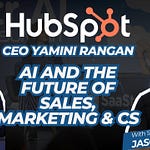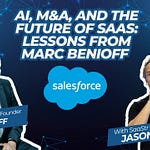Inside Snowflake’s Board Meetings: How AI is Reshaping Enterprise Data and the Future of B2B Partnerships
We had a lot of fun at SaaStr AI Summit 2025 with a rare look inside Snowflake’s boardroom! We featured an unprecedented dynamic: Jeremy Burton sits on Snowflake’s board while simultaneously running Observe, a company built 100% on Snowflake’s platform. Together with Snowflake’s CEO, Sridhar Ramaswamy, they joined us live on stage.
This unique relationship reveals how the $4.5B ARR data cloud leader is adapting to AI disruption, the evolution of technical sales, and what it really takes to build strategic partnerships that scale.
Top 5 Takeaways
Consumption Revenue Recognition Changes Everything: Unlike traditional SaaS, Snowflake can’t recognize revenue ratably—they only book revenue when customers actually consume credits, even with multi-year contracts. This creates hyper-aligned incentives where sales success is measured by use case creation, not deal size.
Technical Sales is Now Table Stakes: Enterprise sales reps must understand technology applications deeply enough to have credible conversations with both business executives and technical teams. The days of relationship-only selling are over in AI-adjacent markets.
Separate Teams for Land vs. Expand: Snowflake completely separates new customer acquisition from account growth teams. Growing a $50M account requires managing 20+ people and knowing customer architecture better than the customer—a fundamentally different skill than closing new deals.
Strategic Partnerships Need Internal Champions: Real partnerships only exist when someone’s career depends on your success. Without an internal champion whose future is tied to yours, you’re just a vendor getting lip service.
AI Will Reshape Technical Roles in 18 Months (or Less): Data engineers will become orchestrators rather than code writers. Data analysts will shift from writing SQL to providing semantic context. The next 18 months will bring more change than the previous four years.
At SaaStr, we’ve seen everything from scaling revenue to product-market fit. But this year, attendees wanted something different: a real board meeting. And we delivered something unprecedented—a live board meeting discussion featuring Snowflake’s leadership and Jeremy Burton, CEO of Observe, who sits on Snowflake’s board and runs a company 100% built on Snowflake’s platform.
The conversation revealed fascinating insights about how AI is transforming enterprise data, the future of technical sales, and the mechanics of truly strategic partnerships in the age of consumption-based pricing.
The AI Data Cloud Vision: Beyond Traditional Analytics
Snowflake’s vision is clear: become “the AI data cloud”—a platform where any business user can interact with their enterprise data using natural language, just like ChatGPT but with access to every dataset in their organization.
“Imagine being able to do that on every data set that your company has,” explained Snowflake’s Ramaswamy during the session. “The pieces to do that are already there. We have internal examples of agents that are pretty magical when you bring it all together.”
But customer expectations are evolving rapidly. The CMO of a major mobile carrier told Snowflake: “I have all this information in Snowflake. I want to build a better churn detection engine. How do I automate this process and make it much easier?”
Meanwhile, companies formed through acquisitions face different challenges. One enterprise customer managing 60 different SAP instances asked: “If you were to ask me how much money am I making with this one particular customer, honestly I can’t tell you. What can you do to help me bring it all into a single pane of glass?”
The key insight: AI isn’t just about better analytics—it’s about making data accessible to business users who previously needed data scientists and engineers to get answers.
4 Learnings on Snowflake’s Future Direction
The CFO Test is Coming: As Snowflake bills become the “second largest after AWS” for many enterprises, the pressure to prove ROI will intensify dramatically. Success will be measured not just by data storage and processing, but by demonstrable business value creation from that data.
Business Users Will Drive Consumption Growth: The biggest unlock isn’t more data engineers—it’s enabling any business user to query data like ChatGPT. When marketing managers can ask natural language questions of customer data without SQL, consumption explodes geometrically.
Agent AI Will Create the Next Platform Layer: Snowflake is building internal agent examples that can automatically stitch together data flows, recommend use cases, and provide real-time business intelligence. This isn’t just analytics—it’s autonomous business intelligence that acts on data insights.
The Backlog Problem Becomes the Opportunity: Most enterprises have an “insatiable demand” for data insights but limited technical resources. AI that makes data 10x more accessible means 10x more questions get answered—and 10x more Snowflake consumption gets driven.
The Consumption Model Revolution
One of the most revealing moments came when discussing Snowflake’s consumption-based revenue model. Unlike traditional SaaS companies that recognize revenue ratably over contract terms, Snowflake only recognizes revenue when customers actually consume their credits—even with multi-year pre-commits.
“The consumption model is fabulous because we get paid on usage. Our reps are now focused on making sure that you get value from whatever it is that you signed for,” Jeremy explained. “That’s a super aligned incentive.”
This creates a fundamental shift in how sales teams operate. Success isn’t measured by contract value, but by use case creation. Every week, Snowflake lives and dies by: How many new use cases did you create? How many did you win? How many went live?
Separate Teams: The Acquisition vs. Growth Playbook
To manage this consumption model effectively, Snowflake has implemented a critical organizational structure: completely separate teams for new customer acquisition versus existing account growth.
“The teams that close the customers are off the deal when it closes. They keep it for a year to year and a half, but the set of people that get new accounts are completely distinct from the set of people that are growing existing accounts. Honestly, it’s a different skill.” per Ramaswamy.
The account growth managers are essentially running mini-consulting businesses:
Managing accounts spending $50+ million annually
Leading teams of 20+ people
Understanding customer architecture better than the customers themselves
Making business proposals for new projects and use cases
This specialization makes sense given the complexity. These account managers often know their customer’s technical architecture better than the customer does because they talk to everyone within the organization.
The New Technical Requirements for Enterprise Sales
Perhaps the most striking insight was about the technical requirements for modern enterprise sales. In the age of AI, traditional relationship-based selling isn’t enough.
“You have to be able to have a credible conversation with either a business executive or somebody that is technical and be able to distill out what’s the problem that really matters to them and how Snowflake applies,” per Ramaswamy.
But there’s a crucial distinction between deep technical knowledge and business application knowledge:
What sales reps DON’T need to know: That Snowflake’s image recognition uses a 7-billion parameter model developed internally.
What they DO need to know: If you want to extract numbers from PDF contracts, Snowflake can do that.
“You need to know the application of technology to business. Those are our best account executives.”
This shift is so pronounced that one founder shared a story about closing a seven-figure deal with OpenAI, where their “relatively technical CRO” was left in the lobby because the technical questions from the engineering team were simply too sophisticated for traditional sales approaches.
The 100% Platform Commitment: Observe’s Bet on Snowflake
Jeremy Burton’s story with Observe provides a fascinating case study in platform commitment. When Observe was founded in late 2017, the decision to build 100% on Snowflake was controversial enough that it cost them founding team members.
“There was a bunch of folks who had a theory that every query had to return in 100 milliseconds,” Burton explained. “They wanted to build their own database. My thesis was quite simple: if we’ve got our engineering team adding value above the database and we let the Snowflake team build the database, then we should be able to add more value and therefore charge more money.”
The commitment required accepting worse gross margins initially—paying the Snowflake bill while building their business. But the results speak for themselves: Observe now runs 190 million Snowflake queries daily, ingesting a petabyte of data, with gross margins reaching 60% at tens of millions in revenue.
The key lesson: “If you make that decision early on that you’re going to build on a platform, you’ve got to realize you are picking up a dependency. You have to build relationships.”
The Partner Ecosystem Reality Check
Burton’s insights into building strategic partnerships were particularly valuable. The relationship between Observe and Snowflake works because of genuine mutual benefit:
Observe helps Snowflake customers burn down large credit commitments
Snowflake reps get paid on consumption regardless of whether credits are used in Observe’s multi-tenant environment or customer’s own Snowflake instance
The relationship provides warm, credible introductions into enterprise accounts
But Burton was clear about what it takes to become a strategic partner:
“Unless there’s someone in Snowflake whose career and future depends on you succeeding, you don’t have a partnership. And by the way, that’s true for every company. Never believe a company that says ‘Hey welcome, you’re a partner. Come spend money on me.’ They just want your money.”
The partnership hierarchy insight: Snowflake focuses on a limited number of partners—dozens, not hundreds—but invests significantly in each. For smaller partners, they use a rational model: prove $5 million in joint revenue with one person, and you get the next level of investment.
The Future of Data Engineering and DevOps
Looking ahead 12-18 months, both leaders see dramatic changes coming for technical roles:
Data Engineers will shift from manually setting up pipelines and writing code to becoming orchestrators, with AI handling much of the actual code generation—similar to how Cursor is transforming software development.
Data Analysts will evolve from writing thousands of SQL queries to providing semantic context to datasets, making them “AI-ready” so business users can get value directly.
DevOps Engineers may see the most dramatic change. Burton envisions AI systems that not only identify issues but propose and execute solutions: “Hi, it’s 11:12. I’ve noticed this spike in issues. I’m 90% sure this is the answer. Jeremy, would you like me to execute that?”
The ultimate goal? “We want to build features, not fix problems.”
Key Takeaways for B2B Leaders
Consumption models create different incentives: Success metrics shift from deal size to use case creation and actual value delivery.
Technical sales is table stakes: In enterprise B2B, especially in AI-adjacent markets, sales teams must understand technology applications, not just relationships.
Platform commitment requires total commitment: Half-measures in platform partnerships don’t work. You’re either all-in or you’re not really in.
Strategic partnerships need internal champions: Someone’s career must depend on your success, or you’re just a vendor.
AI will dramatically reshape technical roles: The next 18 months (or less) will see more change in data engineering and DevOps than the previous four years combined.
As we head into 2026, the companies that understand these shifts—consumption models, technical sales requirements, and true platform partnerships—will be the ones that capture the AI-driven enterprise opportunity.
The board meeting format revealed something crucial: the real decisions and insights happen when leaders can speak candidly about what’s actually working. Sometimes the most valuable learning comes not from the keynote, but from listening in on the conversations that shape billion-dollar platforms.
4 Unexpected Learnings from the Snowflake Board Room
Observe Runs 190 Million Queries Daily (Out of Snowflake’s 5 Billion): Despite being “only” at eight figures in revenue, Observe represents nearly 4% of Snowflake’s total daily query volume. This shows how strategic partners can punch way above their weight class in consumption models—revenue size doesn’t always correlate with platform impact.
Sales Reps Don’t Need to Know the Technical Details: You don’t need to understand that image recognition uses a 7-billion parameter model. You DO need to know that you can extract numbers from PDF contracts. The best enterprise sales reps master pattern matching between business problems and technology applications, not the underlying tech stack.
Platform Commitment Cost Them Founding Team Members: Observe’s decision to build 100% on Snowflake was so controversial it literally caused founding team members to quit. The lesson: true platform bets require accepting dependency and worse initial margins, but those who commit fully can reach normal SaaS margins at scale.
The “Golf and NBA Finals” Sales Approach is Dead: When one founder’s team closed a seven-figure deal with a leading LLM, their “relatively technical CRO” was left in the lobby because the engineering questions were too sophisticated. Relationship selling without technical credibility has zero value in today’s enterprise deals.











Share this post